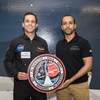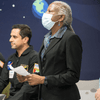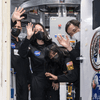New HERA Crew Begins Their Journey to Mars at Johnson
If you could experience a journey to Mars without leaving Houston, would you do it?
For the all-volunteer HERA (Human Exploration Research Analog) crews, the answer is yes.
On May 10, 2024, the latest four-person crew entered the HERA habitat at NASA’s Johnson Space Center, beginning a simulated 45-day mission to Mars. Living and working like astronauts traveling to the Red Planet will help NASA study how isolation and confinement may affect crew members on deep-space voyages.
The HERA team and leaders from NASA’s Human Research Program hosted a celebration for the Campaign 7 Mission 2 crew members before they entered the habitat. Karen Lawrence, campaign lead, opened the event by introducing the crew members. In a first for HERA, one crew member, Shareef Al Romaithi, hails from the United Arab Emirates (UAE) and will participate in the mission through a partnership between NASA and the UAE’s Mohammed Bin Rashid Space Centre (MBRSC). Several MBRSC officials attended the ceremony to show their support for Al Romaithi and the HERA mission.

Bryan Caldwell, NASA complement scientist, spoke about the intensive training the crew and crew alternates completed to prepare for their mission, noting that each had spent about 153 hours attending lectures, participating in hands-on demonstrations, and conducting physiological measurements and surveys. “The entire HERA team thanks you for your diligence and your dedicated focus during the pre-mission phase of Mission two,” he said. “Despite the physical isolation of the habitat, the HERA team and your family and friends will work hard to support you throughout the mission.”
Family and friends were invited to share words of love and encouragement before the crew transitioned over to the HERA habitat. The crew also offered some parting words of appreciation for their family’s support and the HERA team’s work. “We would like to thank the entire NASA HERA team for the pre-mission training and the dedication that you’ve put into this. Thank you so much for setting us up for success and we look forward to seeing everyone in 45 days,” said Stephanie Navarro.

Right before HERA’s doors closed and the simulated journey began, Ted Babic, HERA operations lead, rang the bell that hangs outside of the HERA habitat. “I hereby turn the space vehicle over to its crew,” he said. “May it be a safe home for you on your way to Mars and back to Earth. Congratulations and good luck.”
The crew will conduct multiple operational tasks and participate in 18 different human health studies during their mission, seven of which are collaborations with the MSBRC and the ESA (European Space Agency). The experiments will evaluate the crew members’ physiological, behavioral, and psychological responses in an environment similar to what astronauts will face on a trip to Mars. Insights gleaned from the studies will allow researchers to develop and test strategies aimed at helping astronauts overcome obstacles on long missions deep into space.
For periodic updates from HERA's Campaign 7 Mission 2 crew, follow Johnson on X, Facebook, and Instagram. (and link each platform out to the respective URLs).
Enjoy additional photos from the HERA Campaign 7 Mission 2 ceremony below.

















